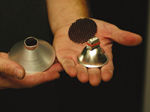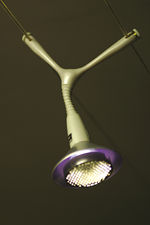Lighting for Dummies Home Theater Reviewers Page 3
It's vital that all of the light sources are balanced for each of the room's many uses or moods. Unfortunately, most good lighting systems have so many lamps on a ton of different dimmers that recalling a single scene becomes a hassle. This is where lighting automation comes in.
 We used Lutron's GRAFIK Eye, an industry standard that worked perfectly for this room. The GRAFIK Eye controller comes in two-, three-, four-, and six-load configurations. When we designed the room, we only had three loads, but I like to build growth potential into every project, so we ordered the six-load GRX-3506.
We used Lutron's GRAFIK Eye, an industry standard that worked perfectly for this room. The GRAFIK Eye controller comes in two-, three-, four-, and six-load configurations. When we designed the room, we only had three loads, but I like to build growth potential into every project, so we ordered the six-load GRX-3506.
By home-automation standards, this controller is easy to install and set up. Mind you, high voltage is, by definition, lethal. If you make a mistake, even if you don't burn down the house, you'll still have some serious explaining to do to your spouse—once you get your voice back. All funny visuals aside, this isn't a roadrunner cartoon. If you aren't completely comfortable working on projects that could kill you, please hire a professional electrician to install any lighting fixture or controller.
The four-gang controller measures almost 8 inches across, which is bulky for my tastes. Luckily, the listening room has plenty of attic space to house the main controller. Since this was an open-stud install, it was easy to get all of the 110-volt electrical wiring back to the GRAFIK Eye. Typically, you can find a place to stash the controller other than the middle of your wall; closets work well, for example.
 To access the attic-mounted GRAFIK Eye's scenes, we placed Lutron's seeTouch controller in the listening room. This controller is the size of a standard single-gang wall plate, and it can access four lighting scenes and raise and lower the chosen scene. As you might have guessed by the name, the controller is backlit, so you can find it in a totally dim room. You can even custom-engrave the buttons with the name of the scene. The model we used also has a built-in IR sensor, so we didn't have to install an IR repeater back to the main controller.
To access the attic-mounted GRAFIK Eye's scenes, we placed Lutron's seeTouch controller in the listening room. This controller is the size of a standard single-gang wall plate, and it can access four lighting scenes and raise and lower the chosen scene. As you might have guessed by the name, the controller is backlit, so you can find it in a totally dim room. You can even custom-engrave the buttons with the name of the scene. The model we used also has a built-in IR sensor, so we didn't have to install an IR repeater back to the main controller.
The seeTouch controller is hardwired into the GRAFIK Eye using a proprietary low-voltage four-conductor wire. Once you've wired in the seeTouch, you flip some dipswitches on the back of the controller to select which scenes (1-4, 5-8, 9-12, or 13-16) the seeTouch's four buttons will control.
 If you'd like to install a lighting-control system in your home but don't want to have to deal with Sheetrock damage, consider a radio-frequency control system. An RF-based system is a flexible solution for retrofit installations and for expanding existing hardwired setups. The system revolves around a matrix of proprietary dimmers and scene controllers, and it's based on your home's current wiring scheme, so all you have to do is exchange your switches with the new RF dimmers. Each of the system dimmers has a built-in transmitter that communicates back to a signal repeater, which relays commands from the controllers to the dimmers and accessories. The signal repeater plugs into a standard wall outlet, and you can place it virtually anywhere. Each signal repeater has a limited operational sphere, which means that most wholehouse applications will require a couple of them. Check out systems like Lutron's RadioRA and Vantage's RadioLink.
If you'd like to install a lighting-control system in your home but don't want to have to deal with Sheetrock damage, consider a radio-frequency control system. An RF-based system is a flexible solution for retrofit installations and for expanding existing hardwired setups. The system revolves around a matrix of proprietary dimmers and scene controllers, and it's based on your home's current wiring scheme, so all you have to do is exchange your switches with the new RF dimmers. Each of the system dimmers has a built-in transmitter that communicates back to a signal repeater, which relays commands from the controllers to the dimmers and accessories. The signal repeater plugs into a standard wall outlet, and you can place it virtually anywhere. Each signal repeater has a limited operational sphere, which means that most wholehouse applications will require a couple of them. Check out systems like Lutron's RadioRA and Vantage's RadioLink.
OK, this should give you a rough idea of how to lay out a lighting system for a theater room, so I'll wrap up by suggesting that you visit a lighting showroom and discuss your project with one of the professionals there. If you want to hire a designer, check out CEDIA's Website (www.cedia.org) for a list of designers in your area.
- Log in or register to post comments




































































